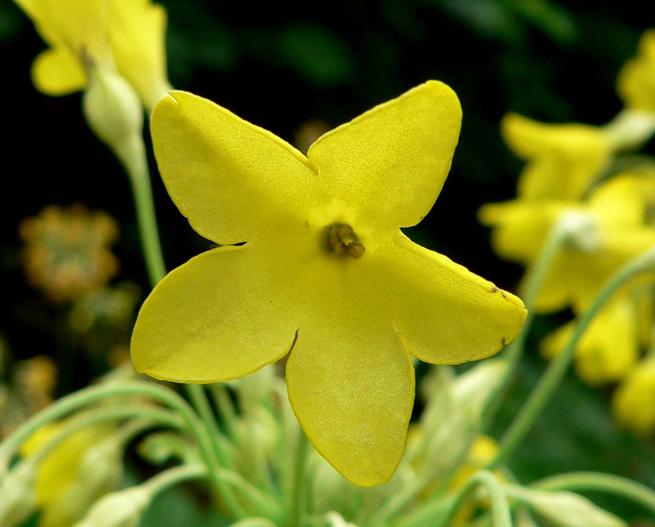Tibetan Cowslip
(Primula florindae)
Tibetan Cowslip (Primula florindae)
/
/

Stan Shebs
CC BY-SA 3.0
Image By:
Stan Shebs
Recorded By:
Copyright:
CC BY-SA 3.0
Copyright Notice:
Photo by: Stan Shebs | License Type: CC BY-SA 3.0 | License URL: https://creativecommons.org/licenses/by-sa/3.0 | Uploader: Stan Shebs | Publisher: Wikipedia Commons






























Estimated Native Range
Summary
Primula florindae, commonly known as Tibetan Cowslip, is a deciduous perennial herb native to wet meadows and by streams in the Himalayas of Tibet. It can reach up to 120 cm (47 in) in height and 90 cm (35 in) in width. The plant features basal rosettes of oblong leaves that are 5–20 cm (2–8 in) long, from which tall flower stalks emerge in summer. These stalks bear clusters of 20–40 nodding, bell-shaped, yellow flowers that are delicately fragrant and have a mealy white bloom on the outside. The flowers are particularly showy due to their size and the contrast with the lush green foliage.
Tibetan Cowslip is valued for its striking floral display and pleasant scent, making it a favorite for waterside plantings, bog gardens, and damp borders. It has earned the Royal Horticultural Society’s Award of Garden Merit, indicating its excellence for garden use. This plant thrives in cool, moist conditions, preferring full sun to part shade. It requires consistently moist soil with slow drainage to mimic its native habitat. While it is cold-hardy, it is essential to ensure that its roots remain moist, especially during winter. Tibetan Cowslip can be susceptible to slugs and snails, which may damage the foliage and flowers.CC BY-SA 4.0
Tibetan Cowslip is valued for its striking floral display and pleasant scent, making it a favorite for waterside plantings, bog gardens, and damp borders. It has earned the Royal Horticultural Society’s Award of Garden Merit, indicating its excellence for garden use. This plant thrives in cool, moist conditions, preferring full sun to part shade. It requires consistently moist soil with slow drainage to mimic its native habitat. While it is cold-hardy, it is essential to ensure that its roots remain moist, especially during winter. Tibetan Cowslip can be susceptible to slugs and snails, which may damage the foliage and flowers.CC BY-SA 4.0
Plant Description
- Plant Type: Herb
- Height: 3-4 feet
- Width: 2-3 feet
- Growth Rate: Moderate
- Flower Color: Yellow
- Flowering Season: Summer
- Leaf Retention: Deciduous
Growth Requirements
- Sun: Full Sun, Part Shade
- Water: Medium, High
- Drainage: Slow
Common Uses
Bee Garden, Bird Garden, Butterfly Garden, Deer Resistant, Fragrant, Hummingbird Garden, Low Maintenance, Rabbit Resistant
Natural Habitat
Wet meadows and by streams in the Himalayas of Tibet
Other Names
Common Names: Giant Cowslip, Himalayan Cowslip, Tibet-Primel, Primevère Estivale Du Tibet, Sommarviva, Tibet-Sommerprimel
Scientific Names: , Primula florindae, Aleuritia florindae,
GBIF Accepted Name: Primula florindae Kingdon-Ward